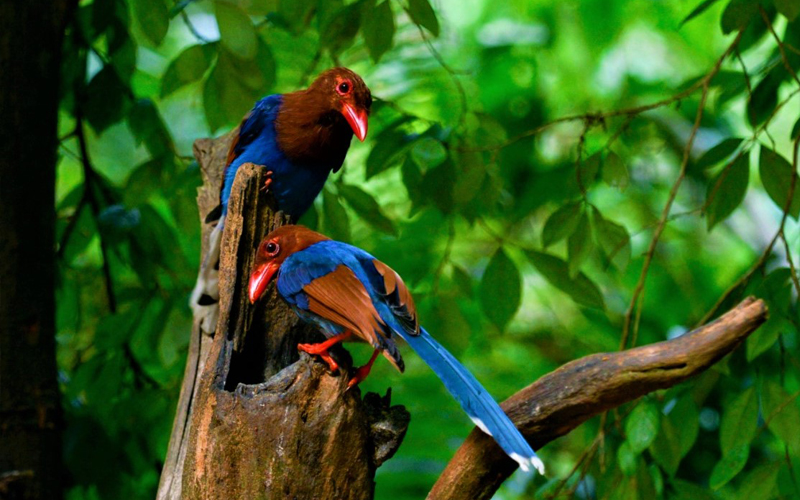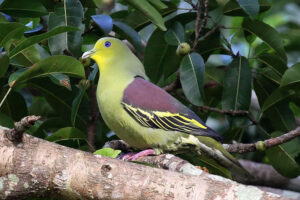About Sri Lanka Blue Magpie
The Sri Lanka Blue Magpie (Urocissa ornata), sometimes known as the Ceylon Magpie (Urocissa ornata), is a vividly colored member of the Corvidae family that can only be found in Sri Lanka. This species has evolved to hunt in dense foliage, where it is exceedingly active and nimble and has adapted to this environment. While flying, it has a limited range and is rarely utilized to travel long distances. Despite the Sri Lanka blue magpie’s capacity to adapt to human presence, it is classed as vulnerable to extinction due to fragmentation and degradation of its habitat, which consists of dense primary forest in the wet zone of southern Sri Lanka’s southern lowlands.

Description
The Sri Lanka Blue Magpie is 42–47 cm in length, and it is larger than a Mynah but smaller than a Crow. It has a strong bill, and it is found in Sri Lanka. A brilliant blue body is contrasted with a reddish-brown or chestnut head, neck, and wing feathers. The blue tail is lengthy and graded, with a white tip at the end of the blue tail. The bill, legs, and feet of this species, as well as its featherless eye ring, are all a brilliant red color. This description applies to both the male and female members of the species.
The juvenile of this species has plumage that is similar to that of an adult, although it is generally duller in appearance, with a brown eye ring and a greyish hue to its blue feathers, particularly on its underbelly, on the underside of its wings. The Sri Lanka Blue Magpie’s moulting season runs from August to November each year.
Taxonomy of Blue Magpie
The Sri Lanka Blue Magpie is a member of the order Passeriformes, which is a subfamily of the Corvidae (birds of paradise).
This species is a member of the Urocissa genus of Southeast Asian Magpies, which contains a total of 5 species that have been identified so far. A recent shared ancestor with another genus of Asian Magpies, Cissa, can be traced back to this group. Cissa and Urocisa are both corvid genera that are native to the Oriental region, which is where the diversity of corvid species had its start. New world jays and magpies are descended from a single ancestor that is thousands of years old.

Habitat and Distribution of Blue Magpie
This species is native to Sri Lanka, where it can be found in tall, undisturbed forests in the highlands, foothills, and adjacent lowlands of the wet zone, as well as in the surrounding lowlands. It can be found at heights ranging from 150 to 2150 meters above sea level. It is not frequently encountered in disturbed habitats such as gardens or plantations, but it can be found there.
Individuals of this species were discovered in 38 distinct forest patches included within six forest complexes within its distribution in the wet zone of southern Sri Lanka, according to surveys undertaken between 2004 and 2006.
Behaviour of Blue Magpie
Despite the fact that they prefer to avoid human-damaged environments, the Sri Lanka Blue Magpie is not only tolerant of but rather attracted to, human presence. The numbers of Sri Lanka Blue Magpies increased in response to low and moderate levels of recreational disturbance, as well as small to medium-sized groups of human visitors, in contrast to the numbers of other birds. On numerous occasions, a group of individuals was observed sitting near paths, anticipating being fed by groups of human visitors.
Where Can Find Blue Magpie?
The Sri Lanka Blue Magpie is an endemic bird species found only in Sri Lanka, primarily in the wet zone forests of the southwestern part of the country. It can be found in areas such as Sinharaja Forest Reserve, Kanneliya Forest Reserve, and the Peak Wilderness Sanctuary. These forests provide the Blue Magpie with the ideal habitat of tall trees and dense undergrowth where they can forage for food and build their nests.
- Sinharaja Rain Forest
- Kitulgala Forest Reserve
- The Peak Wilderness Reserve
- Hakgala Botanical Gardens
- Morapitiya Forest Reserve
Sound
Its vocalizations are extremely varied and include a jingle, a chink-chink, a crakrakrakrak, and a whee-whee.
The Sri Lanka Blue Magpie makes thirteen different types of common calls, including mimicking calls, which have been identified. Individuals have been observed using two raptor calls on a regular basis, usually while mobbing a predator (the Accipiter high-pitched call and the mountain hawk-eagle (Nisaetus nipalensis kelaarti) call). These raptor calls are mimicked by another species that inhabit the same region, the Greater Racket-tailed Drongo (Dicrurus paradiseus), implying that these imitated
Sri Lanka Blue Magpies, on the other hand, do not simply replicate the sounds of predators. In their lengthy and intricate subsong, they have been observed copying the calls and songs of other birds.
Diet
In order to forage, these birds rely on their powerful legs and feet, and they have been spotted hanging upside down and effortlessly holding down their meal.
A large portion of their diet consists of carnivorous organisms such as insects, frogs, and small lizards, but they have also been observed to ingest fruit, and some findings imply that part of their prey may include the eggs or young of other bird species. Blue magpies have been recorded wiping hairy caterpillars against mossy trees to remove the annoying hairs before swallowing them in Sri Lanka, according to reports.
Reproduction
Sri Lanka blue magpies are monogamous, employ cooperative breeding to raise their young, and can be found in small groups of up to seven birds, each of which has its own territory. They can be found in small flocks of up to seven birds.
The Sri Lanka Blue Magpies have a generation length of 6.7 years, which is relatively short. The breeding season lasts from January to March, and a clutch of three to five eggs, which are white with brown dots on them, is laid in a single clutching. Nests in the shape of cups are constructed on the branches of small, slender trees and lined with soft materials like lichen.
Both sexes contribute to the construction of the nest and feeding of the young, with only the female incubating the eggs.

Conservation Status
This species, the Sri Lanka Blue Magpie, is classified as vulnerable due to population fragmentation and a steady reduction in numbers. However, because of their breeding strategy of monogamy and cooperative breeding, surveys conducted in 2004-2006 estimated the population to be between 10,181 and 19,765 individuals. However, because of their effective population size, that estimate has been reduced to between 9,500 and 19,500 individuals to reflect their effective population size.
Currently, habitat degradation due to forest clearing for agricultural land, mining, logging, and human settlement is the most serious threat to the survival of the Sri Lanka Blue Magpie. Despite a moratorium on logging in wet zones in 1990 and legal protection for this species in Sri Lanka, air pollution, forest die-back, and the use of biocides in the hill country continue to be threats to the Sri Lanka Blue Magpie’s population decline, according to the International Union for Conservation of Nature.
Several variables have been cited as factors that inhibit the Sri Lanka Blue Magpie from moving into the disturbed habitat, including the presence of another species called Asian koels (Eudynamys scolopaceus), which operate as brood parasites on the Sri Lanka Blue Magpie’s young.
Conclusion
Sri Lanka Blue Magpie is a fascinating and unique bird species found in the lush forests of Sri Lanka. With its striking blue and black plumage, the Blue Magpie is not only beautiful but also serves an important ecological role as a seed disperser and insect predator. However, like many other species, the Blue Magpie faces threats from habitat loss and human activity.
It’s important that we take steps to protect and conserve the habitats of Sri Lanka’s Blue Magpie and other endangered species, through responsible tourism, conservation efforts, and sustainable practices. By doing so, we can help ensure that future generations can continue to appreciate and admire the beauty of these magnificent birds in their natural habitat.











